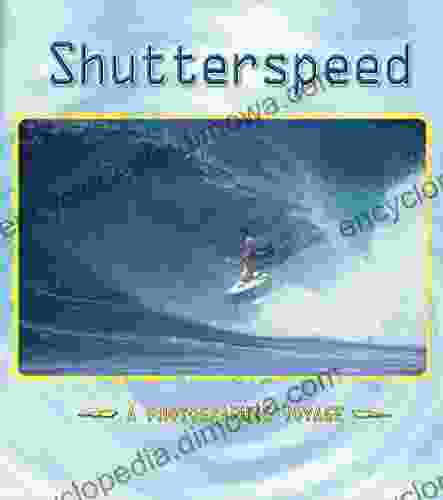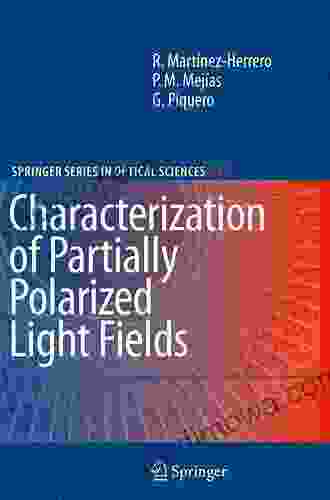Characterization of Partially Polarized Light Fields in Optics: A Comprehensive Guide

5 out of 5
| Language | : | English |
| File size | : | 33245 KB |
| Text-to-Speech | : | Enabled |
| Screen Reader | : | Supported |
| Enhanced typesetting | : | Enabled |
| Print length | : | 351 pages |
Light is a fundamental part of our universe, and it plays a vital role in many areas of science, technology, and everyday life. One important aspect of light is its polarization, which describes the orientation of the electric field vector as the light wave propagates. Light can be fully polarized, partially polarized, or unpolarized, depending on the coherence and directionality of its constituent waves.
Partially polarized light fields are found in a wide variety of applications, including optical communications, imaging, and sensing. Characterizing these fields is essential for understanding their behavior and optimizing their use in these applications.
Fundamentals of Partially Polarized Light
Polarized light can be described using the Stokes parameters, which are four quantities that represent the intensity and polarization state of the light. The Stokes parameters are defined as follows:
- S0: Total intensity
- S1: Linear horizontal polarization
- S2: Linear vertical polarization
- S3: Right-handed circular polarization
- S4: Left-handed circular polarization
The degree of polarization (DOP) of a light field is a measure of how polarized the light is. The DOP is defined as the ratio of the polarized intensity to the total intensity:
DOP = (S1^2 + S2^2 + S3^2 + S4^2) / S0^2
The DOP can range from 0 to 1, with 0 indicating unpolarized light and 1 indicating fully polarized light.
Techniques for Characterizing Partially Polarized Light Fields
There are a variety of techniques that can be used to characterize partially polarized light fields. These techniques can be divided into two main categories: passive and active.
Passive Techniques
Passive techniques do not require any external input to the light field. These techniques include:
- Polarimetry: Polarimetry is a technique that uses a polarizer to measure the polarization state of light. A polarizer is a device that selectively transmits light waves with a particular polarization state.
- Ellipsometry: Ellipsometry is a technique that uses a combination of polarizers and a sample to measure the polarization state of light. Ellipsometry can be used to characterize the thickness and optical properties of thin films.
Active Techniques
Active techniques require some form of external input to the light field. These techniques include:
- Mueller matrix polarimetry: Mueller matrix polarimetry is a technique that uses a set of polarizers and a sample to measure the Mueller matrix of the sample. The Mueller matrix is a 4x4 matrix that describes the polarization properties of the sample.
- Waveplate retarders: Waveplate retarders are devices that introduce a phase shift between the different polarization components of light. Waveplate retarders can be used to create partially polarized light fields.
Applications of Partially Polarized Light Fields
Partially polarized light fields have a wide variety of applications, including:
- Optical communications: Partially polarized light fields are used in optical communications to improve the performance of fiber optic systems.
- Imaging: Partially polarized light fields are used in imaging to enhance the contrast and resolution of images.
- Sensing: Partially polarized light fields are used in sensing to detect and characterize objects and materials.
Partially polarized light fields are a fundamental part of optics and have a wide variety of applications. Characterizing these fields is essential for understanding their behavior and optimizing their use in these applications. The techniques described in this article provide a comprehensive overview of the methods available for characterizing partially polarized light fields.
5 out of 5
| Language | : | English |
| File size | : | 33245 KB |
| Text-to-Speech | : | Enabled |
| Screen Reader | : | Supported |
| Enhanced typesetting | : | Enabled |
| Print length | : | 351 pages |
Do you want to contribute by writing guest posts on this blog?
Please contact us and send us a resume of previous articles that you have written.
 Book
Book Novel
Novel Page
Page Chapter
Chapter Text
Text Story
Story Genre
Genre Reader
Reader Library
Library Paperback
Paperback E-book
E-book Magazine
Magazine Newspaper
Newspaper Paragraph
Paragraph Sentence
Sentence Bookmark
Bookmark Shelf
Shelf Glossary
Glossary Bibliography
Bibliography Foreword
Foreword Preface
Preface Synopsis
Synopsis Annotation
Annotation Footnote
Footnote Manuscript
Manuscript Scroll
Scroll Codex
Codex Tome
Tome Bestseller
Bestseller Classics
Classics Library card
Library card Narrative
Narrative Biography
Biography Autobiography
Autobiography Memoir
Memoir Reference
Reference Encyclopedia
Encyclopedia Avijit Ghosh
Avijit Ghosh Irene Black
Irene Black Dawn Kurtagich
Dawn Kurtagich Tehlor Kay Mejia
Tehlor Kay Mejia A J Hartley
A J Hartley A A Gill
A A Gill A E Chandler
A E Chandler Stephen Neale
Stephen Neale Daniel Alpay
Daniel Alpay Katherine E Kelly
Katherine E Kelly John C Abbott
John C Abbott Mike Morgan
Mike Morgan Anne Driscoll
Anne Driscoll A B Bosworth
A B Bosworth 2012th Edition Kindle Edition
2012th Edition Kindle Edition Conrad Anker
Conrad Anker G Wayne Miller
G Wayne Miller Alice Trinh
Alice Trinh Arthur Mason
Arthur Mason A E Harris
A E Harris
Light bulbAdvertise smarter! Our strategic ad space ensures maximum exposure. Reserve your spot today!

 Kendall WardFlorida Law Enforcement Basic Abilities Test (BAT) Exam Guide: Your Path to...
Kendall WardFlorida Law Enforcement Basic Abilities Test (BAT) Exam Guide: Your Path to... Mike HayesFollow ·13.6k
Mike HayesFollow ·13.6k Mark TwainFollow ·8.7k
Mark TwainFollow ·8.7k Paul ReedFollow ·3.8k
Paul ReedFollow ·3.8k Chadwick PowellFollow ·15.9k
Chadwick PowellFollow ·15.9k Tennessee WilliamsFollow ·18.6k
Tennessee WilliamsFollow ·18.6k Ernesto SabatoFollow ·19.2k
Ernesto SabatoFollow ·19.2k Dashawn HayesFollow ·7.8k
Dashawn HayesFollow ·7.8k T.S. EliotFollow ·15.5k
T.S. EliotFollow ·15.5k

 Zadie Smith
Zadie SmithWork in Early Modern Italy 1500-1800: A Captivating...
: Unraveling the Enigmatic...

 Noah Blair
Noah BlairIceland's Most Unusual Museums: A Quirky Guide to the...
Iceland is a land of natural wonders, from...

 Ross Nelson
Ross NelsonShutterSpeed - A Photographic Voyage
Embark on an Unforgettable Photographic...

 Wayne Carter
Wayne CarterUnveiling the Secrets: Detailed Streamside Field Guide to...
Embark on an unforgettable fly fishing...

 Patrick Rothfuss
Patrick RothfussHannah Montana: Reality Check Junior Novel 19
The Ultimate Behind-the-Scenes Adventure for...

 Chad Price
Chad PriceCreate More Than 30 Projects from Vintage Pieces: Unleash...
Embrace the Art of...
5 out of 5
| Language | : | English |
| File size | : | 33245 KB |
| Text-to-Speech | : | Enabled |
| Screen Reader | : | Supported |
| Enhanced typesetting | : | Enabled |
| Print length | : | 351 pages |










